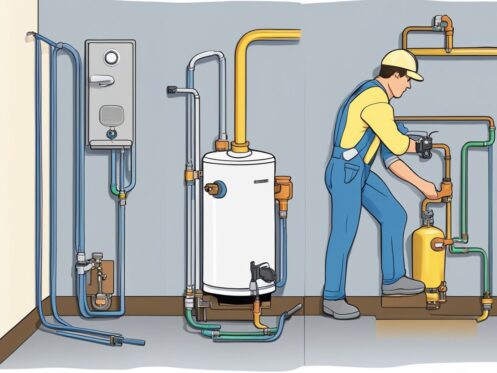If you own a tankless water heater, regular maintenance is key to ensuring its longevity and efficiency. Flushing your tankless water heater at least once a year can help remove mineral buildup that affects performance and lifespan. This simple task not only improves hot water flow but also optimizes energy efficiency, saving you money in the long run.
At Splash Plumbing, we recognize the importance of maintaining your water heater to keep your home running smoothly. By following straightforward steps to flush your unit, you can prevent costly repairs and extend its lifespan significantly. Understanding the flushing process is essential for any homeowner looking to maximize the value of their investment in a tankless water heater.
Embracing this maintenance routine can safeguard against issues such as decreased hot water output and increased energy costs. With proper care, your tankless water heater can continue to provide comfort and efficiency for many years ahead.
Understanding Tankless Water Heater Maintenance
Maintaining a tankless water heater is essential for optimal performance and longevity. Regular care can prevent issues such as scale build-up, which can diminish efficiency and lead to costly repairs. This maintenance involves specific tasks, including flushing, to ensure your unit operates smoothly.
Importance of Routine Maintenance
Routine maintenance for your tankless water heater significantly impacts its efficiency and lifespan. Regular checks can identify potential problems early, preventing major breakdowns. By keeping the unit clean and clear of sediment, you help ensure it heats water effectively when needed.
Key benefits of regular maintenance include:
- Improved energy efficiency
- Extended lifespan
- Consistent water temperature
Ignoring routine maintenance could lead to decreased performance, increased energy bills, and premature replacement.
How Flushing Fits into Regular Maintenance
Flushing your tankless water heater is a crucial aspect of its maintenance. Over time, minerals from hard water can accumulate and create scale inside the heat exchanger. This build-up can hinder water flow and heat transfer efficiency.
To flush your heater, you’ll typically follow these steps:
- Turn off the unit and shut off the water supply.
- Connect a pump to circulate a descaling solution through the system.
- Allow the solution to run for a specified period before flushing with fresh water to remove any remaining solution.
For guidance tailored to your model, check the manufacturer’s recommendations, which outline specific flushing procedures and cleaning solutions.
Frequency of Flushing and Maintenance Schedule
The frequency of flushing your tankless water heater depends on the water quality in your area. Generally, it’s advisable to flush the system once every 12 months. However, if your water is particularly hard, semi-annual flushing may be required.
Consideration of a standard maintenance schedule can be beneficial:
- Monthly: Inspect for leaks, and check filters.
- Every 6 months: Test the pressure relief valve and clean inlets.
- Annually: Perform a full flush and detailed inspection.
Water heater maintenance is essential in keeping your unit running at peak efficiency. If you’re unsure about how to proceed, seeking assistance from professionals like Splash Plumbing can ensure your system is in optimal condition.
Preparing for the Flush
Before you start flushing your tankless water heater, it’s crucial to take certain steps to ensure safety and identify the right tools. Proper preparation makes the process smoother and more efficient.
Safety Precautions and Preparation
Start by turning off the power supply to your tankless water heater. This is critical to avoid any electrical hazards during the flush. If your unit is gas-powered, ensure the gas valve is shut off as well.
Next, allow the water in the heater to cool down for at least 30 minutes. Hot water can cause burns, so this step is essential. You should also consider wearing protective gear, such as gloves and goggles, to safeguard against any splashes or spills.
Finally, have a clear workspace around the water heater to facilitate safe movement and access to necessary tools. These precautions will help you complete the flush without incidents.
Tools and Materials Required
You’ll need several tools and materials to make the flushing process efficient. A tankless water heater flush kit is essential, which typically includes hoses, connectors, and a pump.
You will also require undiluted food-grade white vinegar or a similar descaling solution for the cleaning process. Most manufacturers recommend using around 4 gallons of vinegar for effective flushing.
Additional items include a bucket or container for collecting drained water, and a pair of adjustable wrenches to open the necessary valves. Ensure you have all the tools laid out before starting, as this will save you time and hassle.
Identifying Necessary Valves and Connections
Before the flush, familiarize yourself with the isolation valves and service valves on your tankless water heater. These are crucial for controlling the water flow during the flushing process.
Typically, you will find two isolation valves on the cold water supply line and the hot water line. Make sure you can easily access and operate these valves.
Additionally, identify the connections for your flush kit. Attachments usually connect to the service valves, allowing you to circulate the vinegar through the system. If you are unsure about any connections, consult the manufacturer’s manual or a professional from Splash Plumbing for guidance.
Executing the Flushing Process
Flushing a tankless water heater is essential for removing mineral deposits that build up over time. This section will detail the necessary steps, highlight using vinegar as a cleaning solution, and address how to handle hard water issues effectively.
Step-by-Step Flushing Guide
Begin by turning off the power supply to your tankless water heater. This is crucial for safety during the flushing process. Next, shut off the cold water supply and close the hot water service valve.
You will need a submersible pump or sump pump to help circulate the cleaning solution. Position the pump in a bucket of distilled white vinegar or a vinegar-water mix, then connect it to the heater’s service ports using hoses.
Open the service valves and start the pump. Let the solution flow for about 45 minutes to an hour. After this, turn off the pump, remove the hoses, and flush the system with clean water for 5-10 minutes to remove any remaining residue.
Using Vinegar as a Cleaning Solution
Food-grade white vinegar is an effective cleaning solution due to its acidity, which aids in dissolving mineral deposits like calcium and magnesium. When using vinegar, prepare a mix of equal parts vinegar and water for standard cleaning.
Ensure that the vinegar is distilled white vinegar for optimal results. This type provides the best cleaning power without any additives. Pour the solution into the flushing system, allowing it to circulate through the unit as explained earlier.
If you regularly use this method, it will help prolong the lifespan of your tankless water heater and improve efficiency.
Handling Hard Water and Mineral Deposits
Hard water can lead to significant mineral buildup in your tankless water heater. Implementing a routine flushing procedure, particularly with vinegar, is crucial for maintaining your system.
For homes with consistently hard water, consider installing a water softener. This device reduces calcium and magnesium levels in your supply, minimizing deposits within the heater.
When flushing, pay close attention to the water’s clarity. If you notice a lot of sediment, it may indicate that your unit requires more frequent flushing. Regular maintenance ensures efficient operation and reduces the risk of outages.
For experts in plumbing services, such as the trusted professionals at Splash Plumbing, reaching out can further help you with maintenance tips.
Aftercare and Restarting the Heater
Once you complete the flushing process, specific procedures will help ensure your tankless water heater operates efficiently. Proper aftercare includes following post-flush procedures and reestablishing the water supply, both of which are essential for optimal performance.
Post-Flush Procedures
After flushing, begin by checking all connection points for leaks. Ensure that valves are properly closed before proceeding to restart the system. If you have a Rinnai heater, reference the manufacturer’s guidelines for specific restart protocols.
Next, restore power to the unit. For gas heaters, remember to turn on the gas supply before igniting the burner. It is also important to check for any error codes on the display panel. If any appear, consult your manual or contact a qualified technician for assistance.
Regular maintenance intervals can minimize issues related to water hardness, improving both performance and energy efficiency. Repeating this process annually keeps your heater in top shape, maintaining a reliable hot water supply.
Reestablishing the Water Supply
To reestablish the water supply, first open the cold water supply valve. Check that the water is flowing properly before turning on the hot water valve. Allow the system to fill completely, which may take a few minutes.
You should also flush out any air trapped in the lines by running hot water through the taps. This helps eliminate air pockets that might affect performance. After confirming proper water flow, set the desired water temperature on the thermostat.
If you’re uncertain about any step in this process, reaching out to professionals like Splash Plumbing can ensure everything is done correctly, maintaining your water heater’s efficiency. This attention to detail fosters long-lasting system reliability.
Long-Term Maintenance and Care
Maintaining your tankless water heater is crucial for optimal performance and longevity. Proper care not only extends its lifespan but also enhances energy efficiency and reduces utility bills. Here are some essential practices to consider.
Additional Maintenance Tips
Regular maintenance is key to ensuring your tankless water heater operates efficiently. Schedule an annual descaling treatment to prevent scaling and sediment buildup, which can impact performance. Use a descaling solution or white vinegar for this process.
In addition to descaling, keep an eye on your unit for signs of corrosion or leaks. Check the water filter and water inlet for any blockages, and clean them as needed. These steps can help maintain reliability and prevent water damage. If you’re unsure, consult a professional like Splash Plumbing for assistance.
Installing a Water Softener for Hard Water Areas
If you live in an area with hard water, consider installing a water softener. Hard water can cause significant scaling within your tankless water heater, leading to decreased efficiency and a shorter lifespan. A water softener removes minerals that contribute to scale buildup, improving water quality.
By doing so, you’ll enhance the performance and reliability of your unit while reducing maintenance needs. This investment can lead to long-term cost savings on repairs and energy bills, as it allows your system to operate more efficiently over time.
Understanding the Impact on Utility Bills and Longevity
Flushing your tankless water heater regularly will help keep energy consumption in check. A well-maintained unit uses less energy, which can lead to lower utility bills. Annual maintenance and prompt repairs contribute to an extended lifespan, potentially increasing your heater’s lifespan beyond 20 years.
When you keep your unit in top condition, you also boost its reliability. A reliable water heater can serve you efficiently, helping to avoid unexpected costs from repairs or replacements. By making maintenance a priority, you’ll save money and enjoy continuous hot water for years to come. For reliable plumbing services, reach out to Splash Plumbing.
Frequently Asked Questions
Flushing a tankless water heater is essential for maintaining its efficiency and longevity. Here are some specific questions and answers to help you understand the process better.
What is the correct procedure for flushing a tankless water heater with vinegar?
To flush your tankless water heater with vinegar, start by turning off the power and shutting off the water supply. Connect a flush kit to the heater, and then prepare a mixture of equal parts vinegar and water. Open the valves and let the vinegar circulate through the system for about 15 to 30 minutes before rinsing with clean water.
How frequently should a tankless water heater be flushed to maintain its efficiency?
It’s recommended to flush a tankless water heater at least once a year. If you live in an area with hard water, you may need to flush it more often to prevent mineral buildup that can affect performance.
What type of vinegar should be used when flushing a tankless water heater?
While any vinegar can technically work, it’s best to use white vinegar for flushing. It is effective at dissolving mineral deposits and is less expensive than other vinegar types.
Can you explain the steps involved in using a flush kit for a tankless water heater?
Using a flush kit is straightforward. First, turn off all power and gas supply to the unit. Next, connect the flush kit to the service valves of the heater. Pour the descaling solution or vinegar into the kit, then activate the circulating pump for the recommended time. After flushing, disconnect the kit and open the service valves to flush with fresh water.
What consequences can occur if a tankless water heater isn’t flushed regularly?
Failing to flush your tankless water heater can lead to mineral buildup, which obstructs water flow and reduces heating efficiency. This can cause longer heating times, inconsistent water temperatures, and ultimately damage to the unit, resulting in costly repairs.
Which chemical solutions are recommended for flushing tankless water heaters?
Common chemical solutions include commercial descaling agents specifically designed for water heaters or a simple solution of white vinegar. These options effectively break down mineral deposits without harming the unit.
If you need assistance with flushing your tankless water heater or any plumbing issue, consider contacting Splash Plumbing for expert help tailored to your needs.












